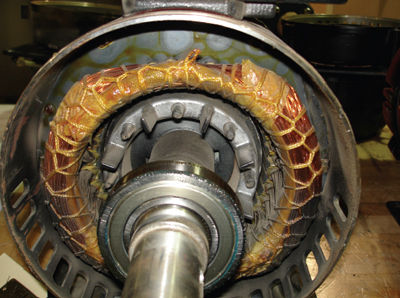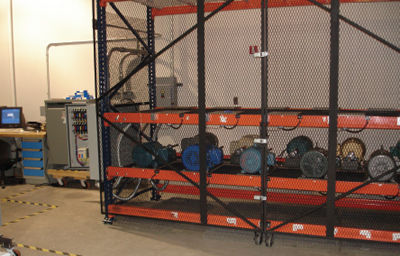In ensuring motor reliability, there is clearly more at stake than profits and expenses; motor and equipment failure can also put an equipment manufacturer’s reputation in the marketplace at risk. OEMs often purchase motors by the thousands or even millions. Since these motors go into products branded with the OEM’s name, the motor’s quality and reliability become synonymous with the OEM, regardless of the motor manufacturer. OEMs are continually challenged to take cost out of their product, and the motor is often one of the most expensive components in the system. With rising iron, steel and copper prices, it is becoming more and more challenging to find low-cost, high-quality motors.
Whether the issue is large motors operating in plants or smaller motors operating in an OEM’s primary product line, both manufacturers and end users are under exceptional pressure to reduce the cost of production, the cost of products and the cost of warranty claims just to stay competitive. If a motor is not performing well over time, an OEM may consider replacing it with a new model. The decision to replace a motor must be given a bit of thought, as it is not a simple switch-out maneuver.
So what is “reliability”? Reliability is the probability that a system will perform satisfactorily for at least a given time period when used under stated conditions. This probability, expressed as a function of time, is called the reliability function or R(t). Reliability engineers measure reliability for non-repairable equipment in mean-time-to-failure (MTTF) while mean-time-between-failures (MTBF) measures reliability in repairable equipment. Assuming a constant failure rate and an exponential distribution, the mean time between failures and the reliability function are expressed as MTBF=total operating time/number of failures.
When motors are used as recommended by their manufacturers, they are usually highly reliable and, just as important, repairable. But while a motor may be repairable, in some cases (such as with small motors) it is more cost effective to simply replace them.

7.5 hp single-phase motor (drive end).
To quantify a motor’s reliability, accurate and dependable data is required. This can be difficult to track and calculate, even if plant personnel can collect historical failure data during operation, because it may not be possible to ascertain the reasons for the failure. In addition, this method often does not allow for accurately recording the operating environment in which the failure occurred, and this is often a key issue in failure because different motors in different environments experience different conditions.
It is also possible to utilize model predictions to analyze equipment and system components to determine failure rates, but this requires complex mathematical formulations. The most pragmatic way to obtain failure data is through physical testing, an approach that is more suitable for smaller motors.
What type of information is beneficial for motor evaluation? There are several ways to evaluate and compare incumbent and potential replacement motors:
-
Inspection build analysis. Early in the process of selecting a motor, product samples should be disassembled and compared to each other as well as to a known motor that the OEM may have used for many years already (incumbent). Manufacturing defects or design differences can be easily pointed out, documented, and even changed by the vendor before proceeding further.
-
Performance characterization. OEMs must be confident that the new motor will work in the given application. It’s best to test a set of sample motors to fully define torque over a given speed range (speed/torque curves). This testing will also demonstrate how well the motor performs under load and temperature, a key issue, as heat kills motors.
-
Endurance testing. After the first sets of tests mentioned above, most OEMs have identified a motor that is a good candidate for further testing. Next comes endurance testing, which should be designed based on the OEM’s equipment’s operating characteristics and the duty cycle the motor will experience under the equipment’s full warranty period. This can also include worst-case scenarios that the equipment might experience during operation. Once the test parameters are defined, several potential replacement motors can be placed in test with several of the incumbent motors for comparative purposes.
-
Post-endurance testing. After the motors have been put through the paces, OEMs should consider testing speed-torque curves and heat runs again to make certain performance has not degraded as a result of the endurance testing beyond an acceptable level.
-
Post-endurance build analysis. During the endurance testing, all motors tested will experience wear but may never fail. No endurance test can account for all of the potential faults a motor might see during operation. Knowing which components in the motors experience the most wear can lead to design improvements in the motor before an OEM takes shipment on the first order from a new supplier.
During endurance tests, the OEM at times requires a number expressing motor reliability for a critical process. To obtain this number, carefully designed testing of a number of identical motors will be necessary. There are two main ways this can be achieved. One is to measure the time to failure for sample motors, fitting the data to an appropriate distribution and analyzing the results, which will reveal the probability of a certain lifetime for the motors. Unfortunately, the sample motors must be tested until each fails, and that may take an extended period of time and not be cost-effective.
The second method specifies the desired motor reliability in a given time period and tests a statistically significant sample to demonstrate that the product meets the reliability goal. A few motors can be tested over a long period of time or a high number of sample motors can be tested in a short time, but both options can be expensive. A compromise can be found through speeding up the testing cycle with a reasonable number of samples that are analyzed with statistical tools to determine reliability. These methods are really only efficient for single-phase motors and three-phase motors smaller than 5 hp, which constitute much of the industrial OEM motor population.







